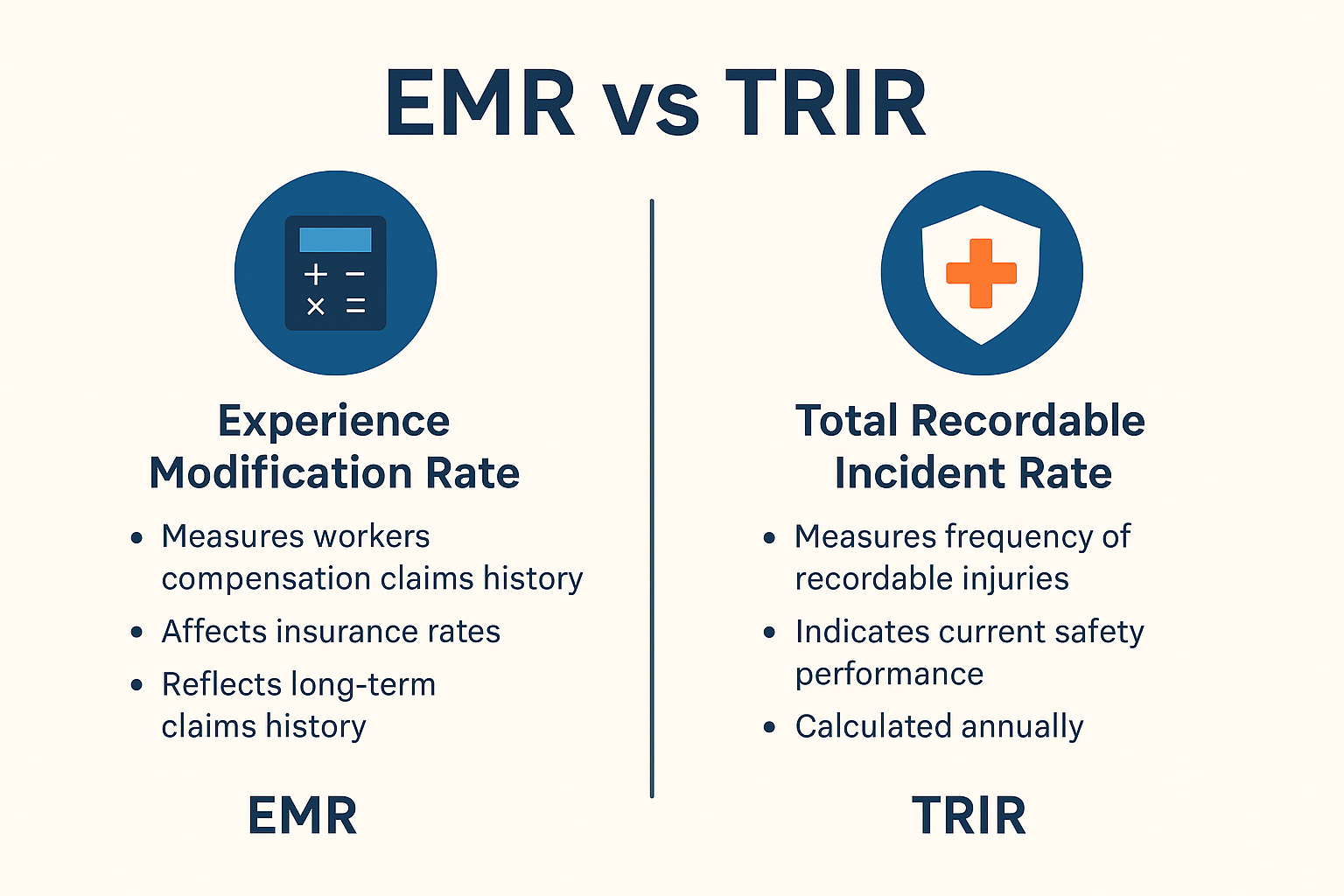When comparing TRIR vs DART, the answer depends on what you want to measure.
TRIR counts all recordable incidents, including minor injuries. DART focuses only on more serious events, like days away from work, restricted duty, or job transfers. TRIR shows the overall volume of safety incidents, while DART reveals how many of those incidents disrupt the job.
If you’re looking to track every safety issue, TRIR gives you that wide view. But if you care more about disruptions to operations, DART tells a clearer story.
In this article, you’ll learn how each metric works, what each one tells you, and how to choose the one that fits your goals.
What is TRIR?
Total Recordable Incident Rate (TRIR), sometimes referred to as Total Case Incident Rate (TCIR), shows how often a company experiences recordable incidents compared to the hours its employees work.
OSHA defines a recordable as any work-related incident that leads to medical treatment, job transfers, restricted work, or other outcomes beyond basic first aid. TRIR counts both major and minor incidents, which makes it a wide measure of occupational health performance.
Safety leaders use TRIR to check the strength of their safety programs and look for patterns in the number of incidents that happen each year. A company’s TRIR gives insight into how well the team handles risks on the job.
If that number rises, it often signals the need for more training, better equipment, or changes in how work is done. When tracked over time, it can show clear progress or decline in workplace safety.
The score also has a part in insurance premiums, especially for high-risk industries. Comparing the result with the OSHA incident rate or the industry average helps put the number in context.
TRIR Formula
Use this formula to calculate TRIR:
(Number of recordable incidents × 200,000) ÷ total number of hours worked
The figure 200,000 represents the hours 100 full-time workers put in over a year. Using this number makes results easier to compare between companies of different sizes.
Example
Say a company logged six recordables and had 150,000 total hours worked in the year. The calculation looks like this:
(6 × 200,000) ÷ 150,000 = 8
That result means eight recordable cases occurred for every 100 full-time workers in a year.
What is the DART Rate?
The Days Away, Restricted, or Transferred (DART) rate measures how often serious incidents cause employees to miss work, change duties, or move to another position. These cases are called DART incidents.
Unlike TRIR, which includes all recordables, DART only tracks incidents that lead to days away from work, restricted work, or job transfers. That makes it one of the most focused safety metrics for tracking workplace disruption caused by injury.
Every work-related injury that forces an employee to take time off or change roles counts toward the DART score. A rising safety DART rate often points to unsafe conditions, gaps in employee training, or poor job planning.
Employers use the DART rate to compare performance to the average DART rate across their industry, helping them identify areas that need work.
Falling behind on this number can raise insurance premiums, damage the company’s reputation, and increase workers’ comp claims. A high DART rate also means the company may be out of step with OSHA incident rate goals or falling short on its occupational health commitments.
Many teams use a DART calculator to simplify reporting and track trends in injury rates and the company’s safety performance.
OSHA DART Rate Formula
The DART rate formula helps employers measure the number of serious safety events that affect their workers. Use this formula:
(Number of DART cases × 200,000) ÷ total number of hours worked
The multiplier of 200,000 represents the hours 100 full-time workers put in over one year. OSHA uses this figure to keep reporting consistent. Every employer can apply it regardless of company size, location, or industry.
Example
Say a company has four DART cases in a year and logs 160,000 total hours worked. The math would look like this:
(4 × 200,000) ÷ 160,000 = 5
That DART rate means five serious incidents per 100 full-time workers. If that’s higher than the industry average, the safety team may need to review current procedures.
Using a DART calculator makes this easier, especially when managing large teams or multiple job sites. Calculating this score regularly helps maintain clear records and supports planning. OSHA reviews DART rates when conducting audits or inspections.
Teams that maintain records and monitor this metric often perform better during compliance reviews and experience fewer surprises.
Common Misconceptions About TRIR and DART
Many safety teams believe a low TRIR proves the job site runs safely. That’s not always the case. A low total recordable incident rate might simply reflect underreporting.
When workers skip reports or avoid seeking medical treatment, the number drops, but the actual risk stays high.
Another common myth claims the DART rate only matters during OSHA inspections. That view misses the broader impact. A poor DART rate can affect insurance premiums, project bids, and a company’s reputation.
Misconceptions to avoid:
- Low TRIR doesn’t always mean strong safety performance
- DART applies beyond audits
- Small issues add up and influence long-term workplace injuries
- Underreporting hides real trends in the work environment
Clear data builds better decisions. Understanding what TRIR and DART measure helps companies track true incident rates and take smarter action.
Choosing the Right Safety Metric for Your Company
Each company needs to choose metrics that align with its goals. TRIR helps track the total number of problems, including recordable incidents that don’t interrupt work. The DART rate focuses on more serious cases, like days away from work, restricted work, or job changes. Which one should you track?
There isn’t a simple answer—business goals shape which number matters more. Companies reporting to regulators may need to watch both. Internal safety teams may focus on reducing downtime, controlling injury rates, and lowering workers’ comp claims.
TRIR works well for spotting broad trends. DART gives a sharper picture of work-related injuries that change how a person does their job. Many firms now track both, along with other metrics like DART score and illness rates.
Use both TRIR and DART when:
- The goal is to improve long-term safety programs
- External stakeholders need clear reports
- Leaders want to identify areas needing faster response
- Teams compare results to industry peers
- Multiple sites require one clear standard
Using more than one metric offers better insight. Teams that balance both stay ahead of problems and build safer operations.
How to Improve (Lower) TRIR and DART Rate
Lowering both TRIR and the DART rate starts with daily action. Each number reflects real conditions on the job, not just paperwork.
To improve results, companies need to fix root causes, focus on what drives recordable incidents, and build habits that reduce the chance of workplace injuries. Small changes, applied consistently, can shift the numbers and create a safer place to work.
Conduct Better Incident Investigations
A strong investigation process helps reduce both TRIR and the DART rate. Every event should lead to fact-based analysis and root cause reviews. That means looking beyond surface-level issues to understand system gaps, habits, or resource problems that allowed the incident to happen.
OSHA and national labor statistics show that poor investigation practices often lead to repeated occupational injuries. Without full understanding, the same hazard returns.
Patterns also emerge when the same types of injuries and illnesses appear across departments. Fixing these root issues lowers the odds of repeat cases and reduces events that could involve days off work or restricted duty.
Steps for stronger investigations:
- Involve supervisors and workers who were present
- Document actions and conditions that led to the issue
- Look for equipment failure, communication gaps, or rushed steps
Companies that stay consistent in their process report fewer severe injuries over the past year and show stronger control over workplace risk.
Proactively Address Near Misses
A missed hazard is just a future injury waiting to happen. Reporting near misses is a proactive approach that helps teams act before someone gets hurt. These incidents may not cause harm today, but still reveal unsafe conditions.
Many companies fail to track near misses, which makes it harder to prevent serious events that can lead to job status or days away from work. By treating every close call as a warning, safety teams gain more insight into risk patterns.
Tracking near misses over time shows where systems need backup or better planning. It also helps reduce future recordable cases and improves your chances of maintaining a low DART rate compared to the industry average.
Train Supervisors on OSHA Reporting Criteria
Confusion around reporting rules leads to bad data. Overreporting adds to your company’s TRIR and DART rate, while underreporting risks compliance trouble.
Every safety leader should teach supervisors what counts as a work-related injury, how to classify time off, and when to list an employee under restricted work or transferred duties.
Supervisors should learn:
- How to spot reportable occupational injuries
- What OSHA expects in injury logs and summary forms
- How to recognize when an injury will likely involve days away
Mistakes in reporting mislead leaders and hurt trust. Clear, repeated training keeps everyone on the same page and supports consistent metrics across all job sites. Accurate data helps safety teams focus on the real issues and protect both workers and the company’s bottom line.
Create a Safety Culture That Encourages Reporting
When workers trust the process, they speak up. A company that rewards honesty builds stronger safety habits. Teams that fear blame keep quiet, even when they spot danger. Silence leads to underreported risk, and that weakens every part of the safety system.
A strong safety culture draws interest from potential employees who want to work for companies that value their health. It also supports better hiring, lower turnover, and more informed operations.
Companies with a healthy reporting culture show fewer surprises, better prevention, and stronger numbers. That foundation makes it easier to improve both TRIR and the DART rate, reduce recordable incidents, and meet expectations from customers, regulators, and insurance providers.
Make OSHA Safety Regulation Metrics Easy to Manage With EHS Momentum
Managing TRIR, DART rate, and other OSHA data takes more than a spreadsheet. Missing details, slow reporting, and unclear logs raise incident rates and hurt safety performance.
EHS Momentum makes tracking faster, clearer, and easier for both field teams and safety leads.
With this tool, companies can:
- Log recordable incidents and track DART in real time
- Monitor the number of incidents, days away from work, and restricted work
- Pull reports by site, date, and case type
- Automate OSHA logs and cut reporting time
Accurate tracking means fewer errors, faster fixes, and better results. Companies that switch to EHS Momentum spend less time chasing data and more time improving the work environment.
Still using spreadsheets for incident tracking? That’s slowing you down. Book a demo and see how EHS Momentum simplifies safety reporting!
FAQs About TRIR vs DART
What is the DART rate for OSHA?
The DART rate for OSHA measures how often employees experience serious injuries or illnesses that lead to days away from work, restricted duties, or job transfers. OSHA uses this metric to evaluate how well a company prevents disruptions caused by workplace incidents. A higher DART rate usually signals more severe problems that impact productivity and workforce safety. This rate only includes cases that result in missed days or changes to an employee’s regular job.
What does TRIR stand for in OSHA?
TRIR stands for Total Recordable Incident Rate. OSHA uses this metric to track the number of recordable incidents per 100 full-time employees over a standard number of hours worked. TRIR offers a broad view of a company’s safety performance by counting all OSHA-recordable cases, including those that don’t involve lost time, such as certain types of medical treatment or first aid beyond basic care.
What does DART stand for in insurance?
In insurance, DART refers to Days Away, Restricted, or Transferred. Insurers often look at a company’s DART rate when evaluating risk and setting premiums. A higher rate may indicate more frequent or serious injuries, which can lead to increased claim payouts and higher insurance costs.
What is DART in HR?
In human resources, DART tracks the number of cases where injuries or illnesses result in employees being temporarily unable to do their full job. HR teams use this data to manage workers’ comp cases, assess job reassignments, and understand how many missed days stem from safety-related events. It helps HR coordinate recovery plans and support employees while maintaining productivity.








